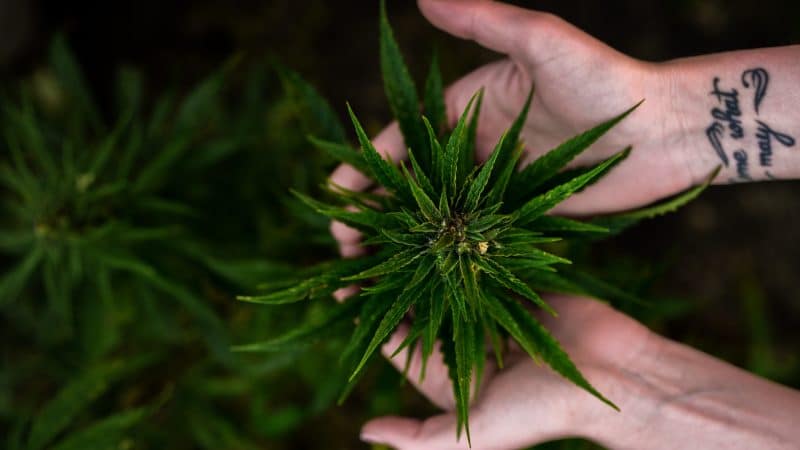Easiest Guide on How to Grow Marijuana in 9 Simple Steps

So, you love smoking pot and live in a state where growing your own weed is perfectly legal? Then, what are you waiting for? It’s time to learn how to grow marijuana in the comfort of your own home!
One of the reasons why people are discouraged from growing their own cannabis plant is that they believe it to be a costly, complicated, and time-consuming project when in reality, it is not so.
If you follow these simple steps, you will learn how to grow the best and most potent buds.
So, let’s dig in!
Step 1: Choose the Location
The absolute first thing to decide when you are learning how to grow weed is whether you are growing pot indoors or outdoors.
Whatever you choose, remember that the smaller the project, the lower the risk. If you’re just trying your hand at growing marijuana, start small. Not only are the costs for one plant lower, but it’s also easier to take care of one plant instead of ten.
That said, leave some extra room. If you’re lucky, your plant might triple in size, or you might be a super successful grower and move on to cultivating more plants in no time.
Indoor vs. Outdoor Cannabis Cultivation
In general, plants grown outdoors are bigger and, as a result, produce bigger yields. Furthermore, you get to utilize natural light and other elements (free of charge), which means costs are considerably lower.
On the other hand, growing plants indoors can be a hefty investment to set up, but you have more control in terms of harvest and pest control.
When it comes to learning how to grow marijuana outdoors, you must also consider the legal issues. For example, if you want to grow pot in some states, you have to keep plants hidden from public view, which is not an issue with indoor growing.
However, the biggest difference is that outdoor plants flower only once a year (you plant them in spring and harvest them in fall). In contrast, if you grow them inside, you can harvest them whenever you want.
The good news is that there is little to no difference in potency and taste (unless you have an extremely sensitive palate for cannabis), so choosing the environment, where, and how to grow your own weed is entirely up to you.
If you choose the great outdoors, make sure you find a place that has access to plenty of light and enough room for the plant to grow naturally. Also, buy seeds for an outdoor strain; just to make the process a bit easier.
Growing tip: Outdoor plants need at least 8 hours of direct sunlight per day. So, choose a location that provides your precious plants with plenty of sunshine!
How to Grow Weed Indoors for Beginners
If indoors is more your style, then let’s look over some of the things you’ll need to get started.
Decide on a Grow Room
You can grow cannabis almost anywhere you want. It can be in a spare room, a closet, a garage, or even a grow tent.
In fact, grow tents are a good choice because they come with many advantages. You can quickly put them up and take them down; they’re a cheap indoor grow setup, and some of them even come with extra features (like hydroponic equipment or separate chambers for cloning).
Your grow room doesn’t have to be some kind of hi-tech lab. Just make sure it is dry and cool and that you have enough space.
Lighting
One of the great things about growing marijuana inside is you get to control the light. And, thus, the yield and the harvest.
Of all the investments in indoor growing, lighting will probably set you back the most. However, it is also one of the most important factors for producing a yield rich both in quality and quantity.
What Kind of Lights Can You Use?
- HID (High-Intensity Discharge) lights are most widely used because they are incredibly powerful, quite cheap, and easy to set up. The two main types of HID lights are Metal Halide and High-Pressure Sodium. HID lights produce a lot of heat (note that you will need air-cooled reflector hoods), which can run up quite an electricity bill.
It is costly, but using HID lamps will make the process of growing cannabis easier in the long run, especially if you use smaller MH/HPS grow lights.
- LED lights are among the top choices for growing weed. They are more expensive, but it might be worth paying a few extra bucks as LED lights last longer and are generally more efficient. How to grow marijuana inside using LED lights? Unlike HID, you don’t have to keep the LED lights far away from your precious plant. Keep them 12–27 inches away (below 300 watts) or 31 inches away (over 450 watts).
- LEC (Light Emitting Ceramic). This type of bulb provides more natural light, is less conspicuous, and emits considerable levels of UV light, which is known to up trichome production.
- Fluorescent grow lights. These kinds of lights are perfect for small-time growers because they are cheaper and easier to set up, and they don’t need a cooling system due to the small amount of heat they produce.
The biggest downside would be efficiency (they generate almost 30% less light) and space (you would need bigger lights to achieve the same results as HPS bulbs).
Extra Tips
The optimal lighting for a cannabis plant would be a 400-watt bulb for the vegetative stage and a 600-watt lamp for the flowering phase. Another tip on how to grow weed indoors: invest in a timer to keep the process consistent.
Also, make sure that the light covers all of your plants, as light exposure is crucial to the size and potency of your buds.
Modern Times
There are now modern systems that incorporate lights, hydration systems, and fans, as well as some that come equipped with smartphone technology and a camera so you can keep an eye on your precious plants wherever you are.
Indoor growing systems and tech sure have come a long way from a bulb and a container in the corner of your spare room.
Air, Temperature, and Humidity
Marijuana may have some magical effects on your brain and body, but it is a plant, like all others, and it needs a steady flow of air to grow.
This means that you need an intake for fresh air and an exhaust for stale air, as well as a fan to keep the air moving. If you’re worried about growing weed at home because of the smell, maybe add a carbon filter to the fan.
Filters will also help you regulate the temperature in the grow room, which should be between 70–85°F.
Humidity is another critical factor to consider. Leaves aspirate and release moisture, which can create a problem as too much moisture in the air is the perfect breeding ground for pests and mold.
On top of that, drier environments result in more resin, and who doesn’t want that?
Now that you’re all set up let’s start growing weed.
Step 2: Choose a Grow Medium
Soil
Apart from being the most traditional choice for plans on how to grow a marijuana plant, it is also the easiest. You can use any potting soil provided it doesn’t contain artificial extended-release fertilizer, which is not good for cannabis cultivation.
Super-soil is possibly the best soil for weed because, in this case, you won’t need any extra nutrients.
Or you can just go for an organic potting mix, which is available in most stores. Combine this with the right nutrients, and you’re all set.
How to choose the best soil for cannabis?
The right soil should be airy enough for the oxygen to reach the plant’s roots and have a balanced pH level (between 6.5 and 7.5). Soil with high acidity levels increases the chances of growing a male cannabis plant, an outcome no one is really thrilled about.
Soilless
Another popular grow medium is the soilless, hydroponic medium, i.e., a process in which the roots absorb nutrients through osmosis. This is useful as it allows for faster growth and bigger buds. Still, it requires more precision.
How to grow hydroponic weed?
Some of the materials you can use include mineral wool, coco coir, perlite, and pebbles, although there is more to choose from.
These materials can be used both in hydroponic setups or individual containers. They can also be mixed and matched to get the best possible results.
Some people choose to grow cannabis with roots suspended in the air or in a tank with water, but as you may suppose, these are not the most common of growing mediums.
A highly recommended way to grow pot for beginners is coco coir.
Why and how to grow pot with coco coir?
It is not expensive; it fits both indoor and outdoor growing methods; it holds water well and allows the cannabis plant to take in more nutrients and oxygen as it uses fibrous coconut husks instead of potting soil.
In addition, throwing in too many nutrients will not have as devastating an impact as other growing methods.
To grow weed with coco coir, you need to:
- Find the right coco coir medium
- Mix coco coir and perlite
- Fill your buckets with coco and add clean water.
A word on containers
You can use “smart pots” or plain old gallon buckets. Just make sure that there are holes at the bottom to help boost airflow and provide proper drainage.
How to Grow Cannabis Step 3: Add Nutrients and Water
Unless you opt for super soil, you’ll need nutrients to ensure that your cannabis plant grows up to be strong and healthy. The same goes for hydroponic mediums, although you will need special kinds of nutrients if you are planning on using any of these.
Most nutrients are available in a two-part liquid: one for the vegetative state and another for the flowering state. So, just follow the instructions on the label telling you how to grow a weed plant, and everything will go smoothly.
The most important thing to remember about feeding your pot plant is not to use too many nutrients in the beginning, or you’ll burn your plant. This is actually a fairly common mistake, especially among novice growers.
Raise the dosage of nutrients only if you see that your plant really needs it. For example, if the lower leaves turn yellow (unless it’s 2 or 4 weeks before harvest time when this is normal).
Another thing to be cautious about is the quality of water you use on your pot plant. Water in certain parts of the world can have high amounts of minerals, impacting the intake of nutrients.
Next, there is the hardness of the water or its pH value. 6.0–7.0 pH for soil and 5.5–6.5 pH for hydroponics should be good enough for growing marijuana. If you don’t have that kind of pH value where you live, you can use purified or RO water or add some Cal/Mag supplements.
Step 4 in Growing Marijuana: Choose the Right Strain
Picking the right strain can be a challenge since there are so many to choose from, but it is also one of the more exciting parts of growing your own weed.
Male and Female Marijuana Plants
In the world of cannabis, it is the female weed plant that grows big, seedless buds full of THC. Male plants, on the other hand, pollinate the female ones, filling their flowers with seeds. In other words, you should opt for growing feminized seeds only.
A small tip: seeded flowers don’t qualify as high-grade cannabis, so it’s best to keep the male plants away from the females.
Growers usually have a male marijuana plant if they are trying to breed a new pot strain or need the seeds for another crop.
How to tell if your plant is male or female before flowering?
This can be tricky, so you should look at the guide and photos of male/female plants.
The safest choice would be to buy feminized cannabis seeds. Or use clones as with cuttings, you’ll definitely get a female plant.
How Many Seeds Do You Need to Grow a Plant?
Depending on the germination rate and the number of plants you want to grow, you’ll need about three regular or two feminized seeds for one pot plant.
Choose a Strain
When growing weed, you can go for Indica, Sativa, or auto-flowering strains.
Sativa strains grow tall and develop long buds, whereas Indicas are shorter, do better in the cold, and produce dense buds. Sativas and Indicas also have different effects, so base your decision on what you’ll use the weed for.
Or just use a hybrid — there are plenty nowadays. Speaking of which…
How to Grow Marijuana Indoors and Outdoors Using Auto-Flowering Strains
These strains start flowering automatically, i.e., they don’t need light schedules to move from the vegetative to the flowering stage!
Auto-flowering strains are usually a mix of Indica and Sativa. They are small and compact and provide fast and rapid results.
Some of the downsides of auto-flowering plants are that you can’t clone them, and they sometimes produce lower yields with less THC.
Still, auto-flowering strains are highly recommended among growers, especially newbies who find it challenging to manage the light cycle during the flowering phase.
How long does it take to grow weed with auto-flowering strains? Typically, these strains flower in 3 weeks to a month after the seed is planted, unlike other strains that can take months to bloom.
Growing Marijuana Step 5: Germinating Seeds
Following this step, you will need to make a decision. To use or not to use seeds and clones? And what’s the main difference between the two?
Clones
Clones are basically cuttings from a mature marijuana plant that can be replanted and grown. Sounds simple enough, right?
Actually, the process of growing marijuana from clones can be more complicated, especially for first-timers. Clones can come with genetic issues, and they are very sensitive when replanted, so they need a lot of care and attention.
Possibly the biggest benefit of using clones is the certainty of getting a female weed plant. On top of that, the flowering process is faster, especially when growing marijuana outdoors.
Nevertheless, many growers say that they take pride and joy in growing a marijuana plant from the earliest stages.
How to Grow Weeds From Seeds?
One way to germinate your seeds is to put them directly in the soil or whatever grow medium you are using.
Not only is this the easiest and least stressful method for both the seeds and the growers, but it is also the most natural, and we all know that “natural” is synonymous with “top-quality.”
How to plant seeds?
The seeds should be planted knuckle-deep, the soil should be moist but not too wet, and the temperature should be around 75°F (23°C).
How to grow marijuana from seed? Wait for 3 to 7 days for tiny sprouts to appear, and that’s it! You’re on your way to getting a full-grown cannabis plant.
Another way to germinate seeds is to use the paper towel method.
You need to put the seeds between two moist paper towels until the seeds begin to sprout (this could take anywhere between a day and a week).
As soon as the small sprouts emerge, put the seeds in the soil, cover the top and make sure your plants get plenty of light, water, and heat.
Step 6: Marijuana Vegetative Stage
During the vegetative phase, which begins once your cannabis plant starts growing new leaves and stems, your plant will focus solely on growing big, but not on growing buds. To help it along the way, you need to provide proper care and nourishment. So, how to grow good weed?
If you are growing marijuana outdoors, make sure the plant gets direct sunlight for the better part of the day, ideally between 10 AM and 4 PM.
Growing plants indoors is a different story. One of the biggest benefits of growing marijuana at home is that growers can keep the plant in the vegetative stage for as long they want.
Putting lights on a timer and exposing the plant to a minimum of 18 hours of light every day will trick your cannabis plant into thinking it’s growing time and stay in the vegetative stage for longer.
The longer the plant stays in the vegetative stage, the taller it gets, and of course, this means a bigger yield as well. Smaller plants may start to flower after less than a month. However, the typical length of this phase is 3 to 5 weeks.
How to Grow Bigger Buds Outdoors and Indoors?
It goes without saying that you can let nature take its course, but there are some things during the vegetative stage you can do to make sure that your plants produce bigger and more potent buds.
Stress Training
Low-stress training and Super Cropping involve bending down the branches so the plant grows wider instead of upwards. Be careful not to snap off the branches as you tie them down, especially with outdoor plants, to get bigger buds in the flowering stage.
Pruning
While not everyone feels the same way about more advanced outdoor growing techniques, such as pruning, many growers believe this technique is one of the best ways to achieve an optimal yield. There are three pruning methods you can try:
- Topping — cutting off the top of the plant makes it grow bushier and wider.
- Fimming — This is similar to topping; however, here, you just cut off a little bit of the top. It’s less traumatic than topping, and it increases the yields.
- Lollipopping — This technique removes the side, low branches of the cannabis plant, allowing all the nutrients to get to the top.
Growing Marijuana Step 7: Flowering Stage
Once your pot plant receives 12 hours of darkness every day, it will start producing buds.
You must provide 12 hours of complete, uninterrupted darkness. Light leaks will stress and confuse your plant, making it revert to the vegetative stage or turn it into a hermaphrodite, which results in pollination and seedy buds.
If you’re growing marijuana outdoors, your plant should start flowering naturally as the days get shorter.
How long does it take to grow marijuana in this phase? The blooming stage typically lasts for 8 to 10 weeks and goes on until it’s time for harvest.
In this phase, you can definitely tell if you have a male marijuana plant or a female, not to mention it is the stage when the plant is most vulnerable. Hence, keeping a close eye on its growth is crucial.
Exposing your plants to enough light and air during this phase can also boost your buds. Many growers “flush” their cannabis plant by giving it plain water the last two weeks before harvest to prevent a nutrient build-up.
The most important thing is not to harvest too soon! Yes, we know you’re eager to sample what you’ve grown, but harvesting your plant too early is a sure way to get lower yields.
Growing Marijuana Step 8: Harvesting
The best (and right) time to harvest is when the trichomes on your pot plant start to turn white, but before they become entirely amber.
- According to one of the many High Times growing tips, if you want a more lethargic stone, harvest when trichomes are mostly amber (80–90%).
- If you want a broader cannabinoid profile, begin harvest when the trichomes are 60–80% brown.
- If you are looking for more THC, cut the buds when 70% of them grow darker.
Growing Weed Step 9: Drying and Curing
After the harvest comes trimming, drying, and curing.
It takes about a week for the buds to dry, depending on how humid the area is. Once they dry, place the buds in jars to cure them so that the extra liquid is completely removed.
A small tip: use opaque jars and open them once or twice a day to prevent mold from forming.
The curing process should take about four weeks, after which you will have some nice, high-quality buds to give you that perfect hit!
Bottom Line
Growing your own weed at home or in your garden is next to impossible if you don’t know what you’re doing. So, don’t make decisions on your own, like skipping some of the steps.
Ask other growers about their experiences or google something you’re not entirely sure about. A bit of practice and a good read — that’s what it takes to properly learn how to grow marijuana successfully and without too much hassle.
FAQs
Can you grow marijuana from home?
Yes, you can grow marijuana at home but only in the states that allow growing medical marijuana, such as California, Montana, Oklahoma, Washington, and Massachusetts.
That said, each state has different restrictions regarding marijuana home-growing. In other words, you will be limited by mature plants and/or seedlings.
For example, if you live in Maine, you can grow 6 mature plants for medical use if you’re over 21. At the same time, Californians can possess six plants for personal use while there’s no limit for growing medicinal marijuana.
How can I increase my marijuana plant growth?
To increase the plant’s growth, you can use the following techniques:
- Stress training — bending down the branches to help the plant grow wide, not upwards.
- Topping — cutting off the top of the plant.
- Fimming — cutting off only a little bit of the top.
- Lollipopping — removing the side branches.
In addition to that, an easy hack for how to grow marijuana is to increase the size of the container, giving the plant more space to grow.





